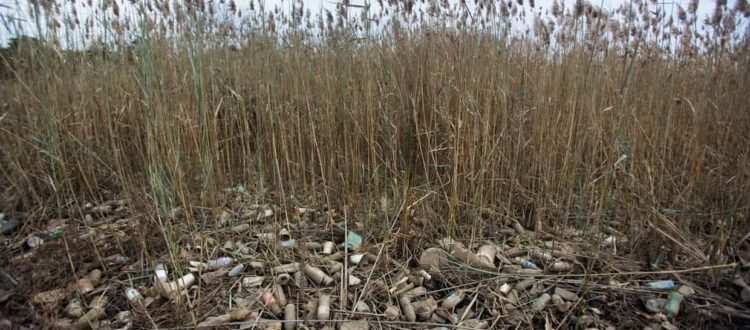Plastic pollution risks 'near permanent contamination of natural environment'
Published on July 25th, 2017
Plastic bottles and other debris gather on the banks of the Anacostia River in Washington DC. Plastic has now outstripped most other man-made materials. Photograph: Jim Lo Scalzo/EPA
First global analysis of all mass–produced plastics has found humans have produced 8.3bn tonnes since the 1950s with the majority ending up in landfill or oceans
By Matthew Taylor
July 19 2017 / July 20 2017
The Guardian
Humans have produced 8.3bn tonnes of plastic since the 1950s with the majority ending up in landfill or polluting the world’s continents and oceans, according to a new report.
The first global analysis of all mass–produced plastics has found that it has outstripped most other man-made materials, threatening a “near permanent contamination of the natural environment”.
The study by US academics found that the total amount of plastic produced – equivalent in weight to one billion elephants – will last for hundreds, perhaps thousands, of years. And with production expected to accelerate over the coming decades, campaigners warn it is creating an environmental crisis comparable to climate change.
“We are increasingly smothering ecosystems in plastic and I am very worried that there may be all kinds of unintended, adverse consequences that we will only find out about once it is too late,” said Roland Geyer, from the University of California and Santa Barbara, who led the project.
In 1950, when plastic was first mass produced, the report found 2m tonnes was manufactured. That figure has risen to 8.3bn in 2017 and is projected to reach 34bn by 2050.
“We are on this enormous growth trajectory – there is no end in sight of the rate of this growth,” said Geyer. He added that even academics who worked in the same field were unaware of the “sheer dimensions” of the crisis.
“Combined with this huge growth rate it makes me very concerned. We should look at the numbers and ask as a society, is this what we want, can we not do better?”
Last month a Guardian investigation revealed that a million plastic bottles are bought around the world every minute and that number is expected to jump another 20% by 2021.
And earlier this year scientists found nearly 18 tonnes of plastic on one of the world’s most remote islands, an uninhabited coral atoll in the South Pacific.
Another study of remote Arctic beaches found they were also heavily polluted with plastic, despite small local populations. And scientists have warned that plastic bottles and other packaging are overrunning some of the UK’s most beautiful beaches and remote coastline, endangering wildlife from basking sharks to puffins.
Experts warn that some of it is already finding its way into the human food chain. Last August, the results of a study by Plymouth University reported plastic was found in a third of UK-caught fish, including cod, haddock, mackerel and shellfish.
But Geyer said he was also concerned about the impact of plastic pollution on land-based ecosystems.
“There is much more attention paid to how plastics are interacting with marine organisms but there is much, much less known about how plastics interact with terrestrial organisms – I would suspect there is something equivalent going on and it might actually be worse.”
This new study found that growth in plastic production has been driven largely by packaging and the rise of single-use containers, wrapping and bottles. It found some of the only materials to outstrip plastic production over the past 70 years are used in the construction sector, such as steel and cement.
“Roughly half of all the steel we make goes into construction, so it will have decades of use – plastic is the opposite,” said Geyer. “Half of all plastics become waste after four or fewer years.”
To visualize the scale of the problem Geyer said he had carried out a “thought experiment”.
“If you take the 8.3bn tonnes of plastic and spread it out as ankle deep waste – about 10 inches high – I calculated I could cover an area the size of Argentina with it. That is the world’s eighth largest country.”
The study found that in 2015, of the nearly seven billion tonnes of plastic waste generated, only 9% was recycled, 12% incinerated, and 79% accumulated in landfills or the environment.
Geyer said: “What we are trying to do is to create the foundation for sustainable materials management. Put simply, you can’t manage what you don’t measure, and so we think policy discussions will be more informed and fact based now that we have these numbers.”





